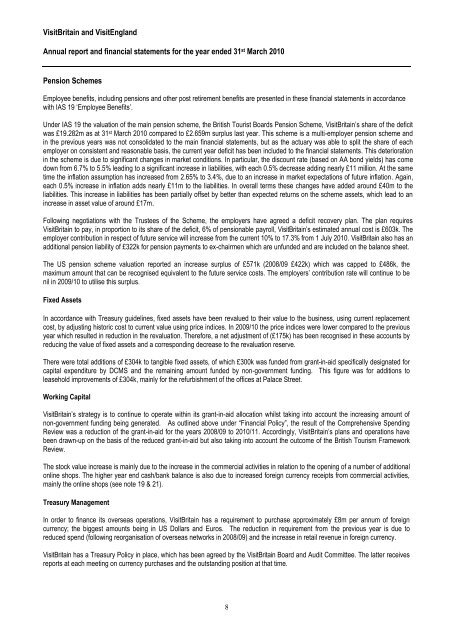BRITISH TOURIST AUTHORITY TRADING AS VISITBRITAIN ...
BRITISH TOURIST AUTHORITY TRADING AS VISITBRITAIN ...
BRITISH TOURIST AUTHORITY TRADING AS VISITBRITAIN ...
Create successful ePaper yourself
Turn your PDF publications into a flip-book with our unique Google optimized e-Paper software.
VisitBritain and VisitEngland<br />
Annual report and financial statements for the year ended 31 st March 2010<br />
Pension Schemes<br />
Employee benefits, including pensions and other post retirement benefits are presented in these financial statements in accordance<br />
with I<strong>AS</strong> 19 ‘Employee Benefits’.<br />
Under I<strong>AS</strong> 19 the valuation of the main pension scheme, the British Tourist Boards Pension Scheme, VisitBritain’s share of the deficit<br />
was £19.282m as at 31 st March 2010 compared to £2.659m surplus last year. This scheme is a multi-employer pension scheme and<br />
in the previous years was not consolidated to the main financial statements, but as the actuary was able to split the share of each<br />
employer on consistent and reasonable basis, the current year deficit has been included to the financial statements. This deterioration<br />
in the scheme is due to significant changes in market conditions. In particular, the discount rate (based on AA bond yields) has come<br />
down from 6.7% to 5.5% leading to a significant increase in liabilities, with each 0.5% decrease adding nearly £11 million. At the same<br />
time the inflation assumption has increased from 2.65% to 3.4%, due to an increase in market expectations of future inflation. Again,<br />
each 0.5% increase in inflation adds nearly £11m to the liabilities. In overall terms these changes have added around £40m to the<br />
liabilities. This increase in liabilities has been partially offset by better than expected returns on the scheme assets, which lead to an<br />
increase in asset value of around £17m.<br />
Following negotiations with the Trustees of the Scheme, the employers have agreed a deficit recovery plan. The plan requires<br />
VisitBritain to pay, in proportion to its share of the deficit, 6% of pensionable payroll, VisitBritain’s estimated annual cost is £603k. The<br />
employer contribution in respect of future service will increase from the current 10% to 17.3% from 1 July 2010. VisitBritain also has an<br />
additional pension liability of £322k for pension payments to ex-chairmen which are unfunded and are included on the balance sheet.<br />
The US pension scheme valuation reported an increase surplus of £571k (2008/09 £422k) which was capped to £486k, the<br />
maximum amount that can be recognised equivalent to the future service costs. The employers’ contribution rate will continue to be<br />
nil in 2009/10 to utilise this surplus.<br />
Fixed Assets<br />
In accordance with Treasury guidelines, fixed assets have been revalued to their value to the business, using current replacement<br />
cost, by adjusting historic cost to current value using price indices. In 2009/10 the price indices were lower compared to the previous<br />
year which resulted in reduction in the revaluation. Therefore, a net adjustment of (£175k) has been recognised in these accounts by<br />
reducing the value of fixed assets and a corresponding decrease to the revaluation reserve.<br />
There were total additions of £304k to tangible fixed assets, of which £300k was funded from grant-in-aid specifically designated for<br />
capital expenditure by DCMS and the remaining amount funded by non-government funding. This figure was for additions to<br />
leasehold improvements of £304k, mainly for the refurbishment of the offices at Palace Street.<br />
Working Capital<br />
VisitBritain’s strategy is to continue to operate within its grant-in-aid allocation whilst taking into account the increasing amount of<br />
non-government funding being generated. As outlined above under “Financial Policy”, the result of the Comprehensive Spending<br />
Review was a reduction of the grant-in-aid for the years 2008/09 to 2010/11. Accordingly, VisitBritain’s plans and operations have<br />
been drawn-up on the basis of the reduced grant-in-aid but also taking into account the outcome of the British Tourism Framework<br />
Review.<br />
The stock value increase is mainly due to the increase in the commercial activities in relation to the opening of a number of additional<br />
online shops. The higher year end cash/bank balance is also due to increased foreign currency receipts from commercial activities,<br />
mainly the online shops (see note 19 & 21).<br />
Treasury Management<br />
In order to finance its overseas operations, VisitBritain has a requirement to purchase approximately £8m per annum of foreign<br />
currency; the biggest amounts being in US Dollars and Euros. The reduction in requirement from the previous year is due to<br />
reduced spend (following reorganisation of overseas networks in 2008/09) and the increase in retail revenue in foreign currency.<br />
VisitBritain has a Treasury Policy in place, which has been agreed by the VisitBritain Board and Audit Committee. The latter receives<br />
reports at each meeting on currency purchases and the outstanding position at that time.<br />
8
















